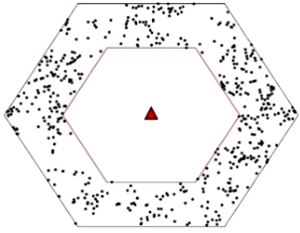Transmit antenna selection for achieving energy efficiency in massive MIMO based 5G cellular network
DOI:
https://doi.org/10.3103/S0735272723020048Keywords:
Massive MIMO, RUS, MCG, Base Station, Energy efficiency, AntennaAbstract
In this study, two dynamic algorithms are verified for transmit antenna selection aimed at achieving the energy efficiency in massive MIMO, namely: Random User Selection (RUS) and Maximum Channel Gain (MCG). Massive MIMO setups are investigated over N radio cables via centralized massive base station (BS), which uses RUS and MCG to provide management to U clients. Massive MIMO networks are shown for 8×8, 16×16, 25×25, and 50×50 setups using RUS and MCG. The proficiency of the proposed scheme on setup network has been investigated with RUS and MCG, and then the effect on performance characteristics, such as sumrate, user throughput and energy efficiency has been analyzed. The power efficiency has also been improved by increasing the number of Massive MIMO antennas. Compared to RUS, algorithm MCG provides a better service to users located far from the base station antenna.
References
- S. K. Mishra, P. Pattanayak, A. K. Panda, “Combined transmit antenna selection and user scheduling in a massive MIMO broadcast system,” in 2020 Advanced Communication Technologies and Signal Processing (ACTS), 2020, pp. 1–6, doi: https://doi.org/10.1109/ACTS49415.2020.9350421.
- S. S. Yilmaz, B. Ozbek, “Compressive sensing based low complexity user selection for massive MIMO systems,” in 2020 IEEE 91st Vehicular Technology Conference (VTC2020-Spring), 2020, pp. 1–5, doi: https://doi.org/10.1109/VTC2020-Spring48590.2020.9129553.
- J. Borah, S. Baruah, S. Das, D. Biswas, “Analysis of massive MIMO and small cells based 5G cellular networks: Simulative approach,” Radioelectron. Commun. Syst., vol. 65, no. 6, pp. 284–292, 2022, doi: https://doi.org/10.3103/S0735272722060024.
- J. Borah, J. Bora, “Energy-efficient ICI mitigation with dynamic and location-based power allocation in mobility-based 5G HetCN,” Wirel. Pers. Commun., vol. 117, no. 2, pp. 1441–1457, 2021, doi: https://doi.org/10.1007/s11277-020-07930-x.
- J. Borah, M. A. Hussain, J. Bora, “Dynamic and energy-efficient ICI mitigation techniques for mobility-based 5G HetCN,” IET Commun., vol. 14, no. 9, pp. 1397–1403, 2020, doi: https://doi.org/10.1049/iet-com.2019.0898.
- J. Borah, T. A. Sheikh, J. Bora, “Dynamic cell sleeping mechanism: An energy‐efficient approach for mobile 5G HetCN,” Int. J. Commun. Syst., vol. 36, no. 5, 2023, doi: https://doi.org/10.1002/dac.5422.
- C.-M. Chen, Q. Wang, A. Gaber, A. P. Guevara, S. Pollin, “User scheduling and antenna topology in dense massive MIMO networks: An experimental study,” IEEE Trans. Wirel. Commun., vol. 19, no. 9, pp. 6210–6223, 2020, doi: https://doi.org/10.1109/TWC.2020.3001224.
- Y.-X. Zhu, D.-Y. Kim, J.-W. Lee, “Joint antenna and user scheduling in the massive MIMO system over time-varying fading channels,” IEEE Access, vol. 9, pp. 92431–92445, 2021, doi: https://doi.org/10.1109/ACCESS.2021.3092754.
- M. Guo, M. C. Gursoy, “Energy-efficient joint antenna and user selection in single-cell massive MIMO systems,” in 2018 IEEE Global Conference on Signal and Information Processing (GlobalSIP), 2018, pp. 838–842, doi: https://doi.org/10.1109/GlobalSIP.2018.8646642.
- C. Chen, R. C. Elliott, W. A. Krzymien, J. Melzer, “Modeling of cellular networks using stationary and nonstationary point processes,” IEEE Access, vol. 6, pp. 47144–47162, 2018, doi: https://doi.org/10.1109/ACCESS.2018.2865182.
- J. Akhtar, K. Rajawat, V. Gupta, A. K. Chaturvedi, “Joint user and antenna selection in massive-MIMO systems with QoS-constraints,” IEEE Syst. J., vol. 15, no. 1, pp. 497–508, 2021, doi: https://doi.org/10.1109/JSYST.2020.3014867.
- M. O. K. Mendonca, P. S. R. Diniz, T. N. Ferreira, L. Lovisolo, “Antenna selection in massive MIMO based on Greedy algorithms,” IEEE Trans. Wirel. Commun., vol. 19, no. 3, pp. 1868–1881, 2020, doi: https://doi.org/10.1109/TWC.2019.2959317.
- M. A. Inamdar, H. V. Kumaraswamy, “Energy efficient 5G networks: Techniques and challenges,” in 2020 International Conference on Smart Electronics and Communication (ICOSEC), 2020, pp. 1317–1322, doi: https://doi.org/10.1109/ICOSEC49089.2020.9215362.
- H. ElSawy, A. Sultan-Salem, M.-S. Alouini, M. Z. Win, “Modeling and analysis of cellular networks using stochastic geometry: a tutorial,” IEEE Commun. Surv. Tutorials, vol. 19, no. 1, pp. 167–203, 2017, doi: https://doi.org/10.1109/COMST.2016.2624939.
- D. Park, “Transmit antenna selection in massive MIMO systems,” in 2017 International Conference on Information and Communication Technology Convergence (ICTC), 2017, pp. 542–544, doi: https://doi.org/10.1109/ICTC.2017.8191036.
- M. Boulouird, A. Riadi, M. M. Hassani, “Pilot contamination in multi-cell massive-MIMO systems in 5G wireless communications,” in 2017 International Conference on Electrical and Information Technologies (ICEIT), 2017, pp. 1–4, doi: https://doi.org/10.1109/EITech.2017.8255299.
- J. Borah, J. Bora, “Dynamic and location-based power allocation mechanism for inter-cell interference mitigation in 5G heterogeneous cellular network,” Int. J. Commun. Syst., vol. 33, no. 15, 2020, doi: https://doi.org/10.1002/dac.4548.


